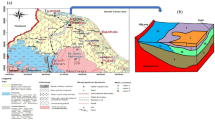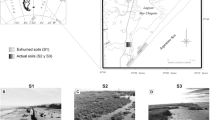Abstract
The artesian borehole R-30–Staro Oryahovo with total depth of 1740 m gives waters of chlorine–sodium type with a mineralization of 31 g/L from formations of Paleogene age. These waters contain high concentrations of iron and because of this, intense precipitation of iron compounds takes place at and around the wellhead. To clarify the ongoing processes, samples of precipitates and overflow water were taken. It was shown that the predominant form of iron in the water before reaching the surface is Fe2+–85–90% and FeCl+–4–11%. The calculated saturation index for a number of Fe2+-containing minerals showed that hydroxides and sulfates of Fe2+ are the possible candidates for sources of iron in the water. The reductive dissolution of wide spread Fe3+-containing minerals (hematite, goethite) was assumed as a possible alternative process releasing Fe2+ into water. At the surface, due to the contacts with the atmospheric oxygen, the environment is sharply changed to oxidizing one thus forming a geochemical barrier and causing mass precipitation of Fe3+ oxides. Simultaneous Fe2+ oxidation, hydrolysis of Fe3+ and co-precipitation with silica and other components are assumed as the major processes causing the formation of low-crystalline Si-containing ferrihydrite or ferrihydrite-like phase. After formation, the precipitated gels due to the processes of aging and continued interaction with the outflowing water have suffered the further change including the formation of goethite. It was shown that due to the intensive precipitation processes, the iron migration to the surface is limited to a very small area and does not affect adjacent agricultural territories with Fe.











taken from a puddle), partially dissolved halite (in the centrum of the micrograph), quartz, biotite, albite (dark-gray). SEM. BSE image

Similar content being viewed by others
References
Abbaspour, N., Hurrell, R., & Kelishadi, R. (2014). Review on iron and its importance for human health. Journal of Research in Medical Sciences: The Official Journal of Isfahan University of Medical Sciences, 19(2), 164–174.
Appelo, C., Drijver, B., Hekkenberg, R., & de Jonge, M. (1999). Modeling in situ iron removal from ground water. Ground Water, 37, 811–817.
Applin, K., & Zhao, N. (1989). The kinetics of fe (II) oxidation and well screen encrustation. Grounwater, 27(2), 168–174.
Arning, E., Kölling, M., Panteleit, B., Reichling, J., & Schulz, H. (2006). Einfluss oberflächennaher Wärmegewinnung auf geochemische Prozesse im Grundwasserleiter. Grundwasser, 11(1), 27–39.
Atanasov, A., Bogdanov, S., & Dachev, H. (1971). Moesian plate. In Y. Yovchev (Ed.), Tectonic structure of Bulgaria (pp. 138–204). Sofia: PH Technika.
Banks, D., Younger, P. L., Arnesen, R. T., Iversen, E. R., & Banks, S. B. (1997). Mine-water chemistry: The good, the bad and the ugly. Environmental Geology. https://doi.org/10.1007/s002540050204
Benderev, A., Hristov, V., Bojadgieva, K., & Mihailova, B. (2016). Thermal waters in Bulgaria. In P. Papic (Ed.), Mineral and thermal waters of southeastern Europe (pp. 47–64). Cham: Springer.
Cismasu, A. C., Michel, F. M., Tcaciuc, A. P., Tyliszczak, T., & Brown, G. E., Jr. (2011). Composition and structural aspects of naturally occurring ferrihydrite. C.R Geosci, 343, 210–218.
Clarke, F., W. (1920). The data of Geochemestry. Fourth edition. U.S. Geol.Survey. Bulletin 695.
Dabovski, C., Boyanov, I., Khrischev, K., Nikolov, T., Sapounov, I., Yanev, Y., & Zagorchev, I. (2002). Structure and alpine evolution of Bulgaria. Geol. Balc., 32(2–4), 9–15.
Davison, W., & Seed, G. (1983). The kinetics of the oxidation of ferrous iron in synthetic and natural waters. Geochimica Et Cosmochimica Acta, 47, 67–79.
Deshev, E. (1981). To the methodology for studying the complexly built natural reservoirs in the Paleogene from the Lower Kamchiya Depression. In P. Mandev & I. Nachev (Eds.), Geology and presence of oil and gas in Northeast Bulgaria (pp. 119–127). PH Technika.
Goldschmidt, V. M. (1954). Geochemistry. Clarendon Press.
Goswami, T., Rolfs, A., & Hediger, M. (2002). Iron transport: Emerging roles in health and disease. Biochemistry and Cell BiolOgy. https://doi.org/10.1139/o02-159
Health Act Safe Drinking Water Regulation BC Reg 230/92 (2003) Queen's Printer, Victoria, British Columbia, Canada. https://www.bclaws.gov.bc.ca/civix/document/id/loo60/loo60/230_92
Hem, J. D. (1985). Study and Interpretation of Chemical Characteristics of Natural Water. Aleksandria: United States government printing office.
Hossain, D., Islam, M., Sultana, N., & Tusher, T. (2015). Assessment of iron contamination in groundwater at Tangail municipality, Bangladesh. Journal of Environmental Science and Natural Resources, 6(1), 117–121. https://doi.org/10.3329/jesnr.v6i1.22051
Houben, G. (2003a). Iron oxide incrustations in wells. Part 1: Genesis, mineralogy and geochemistry. Applied Geochemistry, 18, 927–939.
Houben, G. (2003b). Iron oxide incrustations in wells. Part 2: Chemical dissolution and modeling. Applied Geochemistry, 18, 941–954.
Indian Standard Drinking Water Specification. Eight Reprint (2008). Bureau of Indian Standards. https://ia800404.us.archive.org/11/items/gov.in.is.10500.1991/is.10500.1991.html.
Ivanova, I. S., Lepokurova, O. E., Pokrovskii, O. S., & Shvartsev, S. L. (2014). Iron-containing groundwater in the upper hydrodynamic zone in the central part of West-Siberian artesian basin. Water Resources. https://doi.org/10.1134/S0097807814020080
Jambor, J. L., & Dutrizac, J. E. (1998). Occurrence and constitution of natural and synthetic ferrihydrite, a widespread iron oxyhydroxide. Chemical Reviews, 98, 2549–2585.
Juranov, S., & Pimpirev, H. (1989). Lithostratigraphy of the upper cretaceous and the paleogene in the coastal part of East Stara Planina. Rev. Bulg. Geol. Soc., 30(2), 1–18.
Kančev, I. (1995). Explanatory note to the Geological map of Bulgaria on scale 1:100 000. Committee of Geology and Mineral Resources, Sofia: Dolni Člflik map sheet. Geology & Geophysics Corp. in Bulgarian.
Karagyuleva, Y., & Kostadinov, V. (1975). Geological structure of the eastern part of the Luda Kamchiya zone. Geotect, tectonophys and geodynam, 7, 42–75. in Bulgarian.
Kehayov, T. M. (1982). Atlas of hydrochemical maps of groundwater from the hypergenic zone in the People's Republic of Bulgaria. Scale 1:1000000. Committee on Geology, Sofia, 27 maps (in Bulgarian).
Kraynov, S. R., & Shvets, V. M. (1987). Geochemistry of underground waters for household and drinking purposes. Nedra. in Russian.
Lavrushin, V.Y. (2012). Subsurface fluids of the Greater Caucasus and its surrounding. Transactions of the Geological Institute, vol.599, GEOS, Moscow. (in Russian).
Lieu, P. T., Heiskala, M., Peterson, P. A., & Yang, Y. (2001). The roles of iron in health and disease. Molecular Aspects of Medicine, 22(1–2), 1–87.
Medina, D., Van den Berg, G., Van Breukelen, B., Juhasz-Holterman, M., & Stuyfzand, P. (2013). Iron-hydroxide clogging of public supply wells receiving artificial recharge: Near-well and in-well hydrological and hydrochemical observations. Hydrogeology Journal, 21, 1393–1412.
Mehta, B. C., & Srivastava, K. K. (2012). Iron in ground water in India and its geochemistry. Memoir, Indian society of applied geochemists, 2012, 227–240.
Merrill, D., Shamim, A., Ali, J., Labrique, B., & Christian, W. P. (2012). Groundwater iron assessment and consumption by women in rural Northwestern Bangladesh. International Journal for Vitamin and Nutrition Research. https://doi.org/10.1024/0300-9831/a000089
National Research Council. (1979). Iron. MD, University Park Press.
Ngah, S. A., & Nwankwoala, H. O. (2013). Iron (Fe2+) occurrence and distribution in groundwater sources in different geomorphologic zones of Eastern Niger Delta. Applied Science Research, 5(2), 266–272.
Ordinance §1 of 10.10.2007 for exploration, use and protection of groundwater (2007). State Gazette, Iss. 87 of 30.10.2007 (in Bulgarian)
Palmucci, W., Rusi, S., & Di Curzio, D. (2016). Mobilisation processes responsible for iron and manganese contamination of groundwater in Central Adriatic Italy. Environmental Science and Pollution Research. https://doi.org/10.1007/s11356-016-6371-4
Perelman, A. (1989). Geochemistry. Vishaya Shkola, Moscow, 528 p. (in Russian).
Perelman, A. (1972). Geochemistry of elements in the hypergenesis zone. Nedra. in Russian.
Pezzetta, E., Lutman, A., Martinuzzi, I., Viola, C., Bernardis, G., & Fuccaro, V. (2011). Iron concentrations in selected groundwater samples from the lower Friulian Plain, northeast Italy: Importance of salinity. Environmental Earth Sciences, 62, 377–391.
Possemiers, M., Huysmans, M., Anibas, C., Batelaan, O., & Van Steenwinkel, J. (2016). Reactive transport modeling of redox processes to assess Fe(OH)3 precipitation around aquifer thermal energy storage wells in phreatic aquifers. Environment and Earth Science, 75, 648.
Raju, N. J. (2006). Iron contamination in groundwater: A case from Tirumala-Tirupati environs India. Research Communication, 1(1), 32–35.
Schwertmann, U., & Cornell, R. M. (2000). Iron Oxides in the Laboratory. WILEY-VCH Verlag GmbH.
Stanev, I. (2014). Deep hydrogeological division of Bulgaria. Rev. of Bulg. Geol. Soc., 75(1–3), 5–24. in Bulgarian.
Stefanov, P., Stoyanov, N. (1998). Hydrochemical and geophysical exploration for the salinity evaluation of the parameters of the subterranean waters from deep drillings in the Kamchia reserve in Bulgaria. Proceedings of the 2nd National Geophysical Conference with International Participation, Session 4. “Geological and Geophysical Aspects in the Environment”, Sofia, 21–23 October, p. 132.
Stoyanov, N., Stephanov, P., Spasov, K. (1993). Analysis of the spatial parameters and origin pollution of the quaternary aquifer in the Eastern part of river Kamtchiya liman. Proceedings of the International Conference “Ecology and Industry ‘93”, Sofia, 6–8 October, p. 16.
Stoyanov, N., Spassov, K., Veselinov, V., Shopova, K. (1997). Exploration of the surface and groundwater interaction in the eastern half of the Kamchiya River terrace and its role on the water regime of Kamchiya Reserve in natural and disturbed conditions. Project funded by the Swiss League for the Protection of Nature – Basel.
Stoyanov, N., Gerginov, P., Benderev, A., Boyadjieva, K., Hristov, V., & Vesselinov, V. (2015). Assessment and prediction of potential contamination of groundwater in exploration and production of oil and gas. Rev. of Bulg. Geol. Soc., 76(2–3), 79–88. in Bulgarian.
Stoyanov, N., Trayanova, M., Dimovski, S., & Benderev, A. (2017). Assessment of the impact of deep artesian boreholes on the fresh groundwater in the Kamchia liman region. Geologica Balkanica, 46, 125–133.
Stoyanov, N., & Veselinov, V. (2004). Mathematical prediction model for restoration of the natural water regime in the eastern half of the Kamchiya estuary. BULAQUA, 4, 36–43. in Bulgarian.
Stoykova, K. (2008). Stratigraphy of the Paleocene and Lower Eocene in Northern Bulgaria based on calcareous nanofossils. Dissertation for D.Sc., Geological Institute, BAS, 330 p. (in Bulgarian).
The Drinking Water Directive 98/83/EC. Drinking water legislation - Environment - European Commission. https://ec.europa.eu/environment/water/water-drink/legislation_en.html.
Trayanova, M., & Benderev, A. (2018). Actual state and problems of artesian old oil boreholes in Northern Bulgaria. Rev. of Bulg. Geol. Soc., 79(3), 155–156. in Bulgarian.
Trayanova, M., Haslinger, E., Atanassova, R., Wyhlidal, S., Hristov, V., Kinne, K., & Benderev, A. (2019). Iron in thermal waters in Bulgaria- state and problems. Engineering geology and hydrogeology, 33, 41–50. in Bulgarian.
Trufanov, A. I. (1982). Formation of ferruginous groundwater. Nauka. in Russian.
Tryanova, M., Benderev, A. (2018 b). Ecological assessment of artesian water from well near village of Rasovo (NW Bulgaria). Proceedings 18th International Multidisciplinary Scientific GeoConference SGEM 2018, 30 June - 9 July, 2018,18, Iss. 1.2, 223-230.
Vavilova, M., Dimovski, S., Bryukner, L., Parashkevova, V., Nikolova, M. (1978). Report on the Results of the Deep Drilling in Dolna Kamchiya Area Conducted in 1955–75. Ministry of Energy, National Geological Fund, report III294, 3171 p. (in Bulgarian).
World Health Organization. (1996). Iron in Drinking-water. WHO/SDE/WSH/03.04/08p Background document for development of Guidelines for drinking-water quality 2nd ed. Vol. 2. Health criteria and other supporting information. Geneva, https://www.who.int/water_sanitation_health/dwq/chemicals/iron.pdf
Yovchev, R., Rijova, V. (1962). Groudwaters in Northern Bulgaria. GUGOZN, p. 222 (in Russian).
Yovchev, Y. (Ed.). (1971). Tectonic structure of Bulgaria. Sofia: PH Technika. in Bulgarian.
Zagorcev, I. (1992). Neotectonics of the central parts of the Balkan Peninsula: Basic features and concepts. Geologische Rundschau, 81(3), 635–654.
Zagorchev, I. (2009). Geomorphological zonation of Bulgaria. Principles and state of the art. Comptes rendus de /\l’Academie Bulgare des Sciences, 62(8), 981–982.
Zidarova, E. (1987). Paleogene system. In H. Chemberski (Ed.), Geological Premise for the Oilgas Bearing of the Northeast Bulgaria (pp. 99–108). PH Technika.
Acknowledgements
The research was carried out in the framework of the bilateral cooperation project between Bulgaria and Austria NTCO 1-8 “Scaling and corrosion in hydrogeothermal plants and wells in Austria and Bulgaria—a comparison,” financed by the Austrian Federal Ministry of Science, Research and Economy (BMWFW) and by the Bulgarian Ministry of Education and Science (Scientific Research Fund).
Author information
Authors and Affiliations
Corresponding author
Additional information
Publisher's Note
Springer Nature remains neutral with regard to jurisdictional claims in published maps and institutional affiliations.
Rights and permissions
About this article
Cite this article
Benderev, A., Trayanova, M., Tarassov, M. et al. Conditions and processes of precipitation of iron compounds upon discharge of high-mineralized artesian water from artesian borehole R-30, Staro Oryahovo, Bulgaria. Environ Geochem Health 44, 2235–2251 (2022). https://doi.org/10.1007/s10653-021-01107-6
Received:
Accepted:
Published:
Issue Date:
DOI: https://doi.org/10.1007/s10653-021-01107-6




